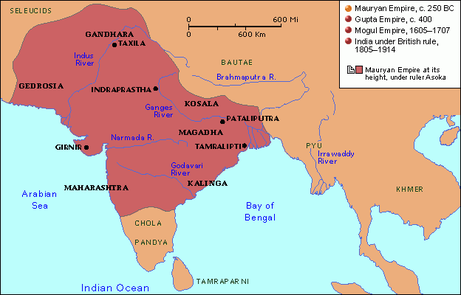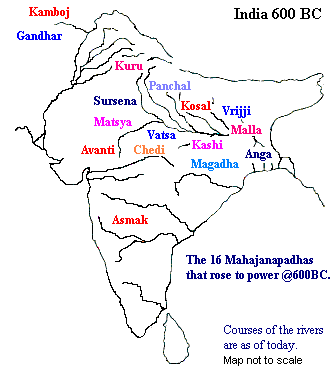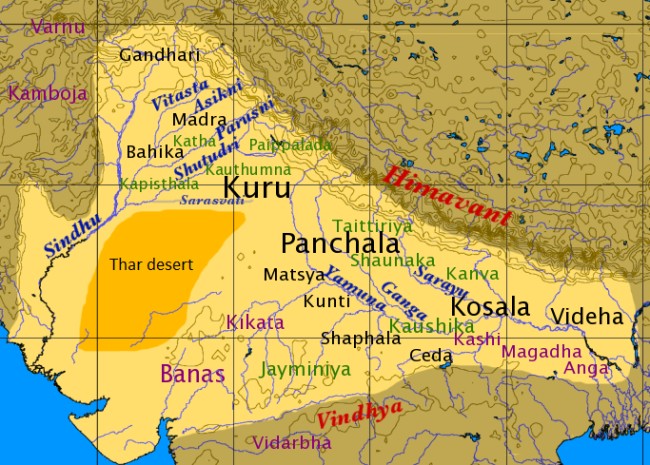
| KAMBOJS Kingdom of Kamboj :
c. 700 BCE – c. 300 BCE :
Kambojs and other Mahajanpads in the Post Vedic period
Kamboj
Kamboj
Kamboj
Kamboj
Vedic period India, with the Kamboj on the northwest border Capital
: Rajapura
The Kambojs were a tribe of Iron Age India, frequently mentioned in Sanskrit and Pali literature. The tribe coalesced to become one of the shodhash (sixteen) Mahajanpads (great kingdoms) of ancient India mentioned in the Anguttar Nikaya. Duryodhan's wife Bhanumati was daughter of Kamboj King Chitrangada and Queen Chandramundra.[citation needed]
Kambojs
as Shudra :
In section 10.43 - 10.44 Manu gives a list of Kshatriya tribes who, through neglect of the priests and their rites, had fallen to the status of Shudras. These are: Pundraks, Codas, Dravids, Kambojs, Yavans, Sakas, Parads, Pahlavs, Chinas, Kirats and Darads.So Kambojs is one of them who fall under shudra varna.
Ethnicity
and language :
Origins
:
Some sections of the Kambojs crossed the Hindu Kush and planted Kamboj colonies in Paropamisadae and as far as Rajauri. The Mahabharat locates the Kambojs on the near side of the Hindu Kush as neighbors to the Darads, and the Param-Kambojs across the Hindu Kush as neighbors to the Rishiks (or Tukhars) of the Ferghan region. [page needed]
The confederation of the Kambojs may have stretched from the valley of Rajauri in the south-western part of Kashmir to the Hindu Kush Range; in the south–west the borders extended probably as far as the regions of Kabul, Ghazni and Kandahar, with the nucleus in the area north-east of the present day Kabul, between the Hindu Kush Range and the Kunar river, including Kapis. However, others have located the Kambojs and the Param-Kambojs in the areas spanning Balkh, Badakshan, the Pamirs and Kafiristan. D. C. Sircar supposed them to have lived "in various settlements in the wide area lying between Punjab, Iran, to the south of Balkh." and the Param-Kamboj even farther north, in the Trans-Pamirian territories comprising the Zeravshan valley, towards the Farghan region, in the Scythia of the classical writers. [page needed] The mountainous region between the Oxus and Jaxartes in present day Tajikistan is also suggested as the location of the ancient Kambojs.
The name Kamboj may derive from (Kam + bhoj "Kam+boj"), referring to the people of a country known as "Kum" or "Kam". The mountainous highlands where the Jaxartes and its confluents arise are called the highlands of the Komedes by Ptolemy. Ammianus Marcellinus also names these mountains as Komedas. The Kiu-mi-to in the writings of Xuanzang have also been identified with the Komudha-dvip of the Puranic literature and the Iranian Kambojs.
The two Kamboj settlements on either side of the Hindu Kush are also substantiated from Ptolemy's Geography, which refers to the Tambyzoi located north of the Hindu Kush on the river Oxus in Bactria, and the Ambautai people on the southern side of Hindukush in the Paropamisadae.[citation needed] Scholars have identified both the Ptolemian Tambyzoi and Ambautai with Sanskrit Kamboj.
Scholars, such as Ernst Herzfeld, have suggested etymological links between some Indo-Aryan ethnonyms and some geonyms used by Iranian-speaking peoples of the Caucasus Mountains and Caspian basin. In particular, Kamboj somewhat resembles the hydronym Kambujiya – the Iranian name for the Iori/Gabirri river (modern Georgia/Azerbaijan). Kambujiya is also the root of Cambysene (an archaic name for the Kakheti/Balakan regions of Georgia and Azerbaijan) and the Persian personal name Cambyses. (A similar link is suggested between the Kur River, which is near the Iori, and the name of the Kurus and Kaurav mentioned in vedic literature.) Such etymologies have not, however, been universally accepted.[citation needed]
Kambojn
States :
Kautiliya's Arthshastra and Ashok's Edict No. XIII attest that the Kambojs followed a republican constitution. Panini's Sutras tend to convey that the Kamboj of Panini was a "Kshatriya monarchy", but "the special rule and the exceptional form of derivative" he gives to denote the ruler of the Kambojs implies that the king of Kamboj was a titular head (king consul) only. One king of Kamboj was King Srindra Varman Kamboj.
The
Asvaks :
It was on account of their supreme position in horse (Ashva) culture that the ancient Kambojs were also popularly known as Ashvaks, i.e. horsemen. Their clans in the Kunar and Swat valleys have been referred to as Assakenoi and Aspasioi in classical writings, and Ashvakayans and Ashvayans in Panini's Ashtadhyayi.
The Kambojs were famous for their horses and as cavalry-men (ashva-yuddh-Kushal), Ashvaks, 'horsemen', was the term popularly applied to them... The Ashvaks inhabited Eastern Afghanistan, and were included within the more general term Kambojs.
—
K.P.Jayswal
—
Etienne Lamotte
The Ashvayans (Aspasioi) were also good cattle breeders and agriculturists. This is clear from the large number of bullocks that Alexander captured from them – 230,000 according to Arrian – some of which were of a size and shape superior to what the Macedonians had known, and which Alexander decided to send to Macedonia for agriculture.
Migrations
:
There are references to the hordes of the Sakas, Yavans, Kambojs, and Pahlavs in the Bal Kand of the Valmiki Ramayan. In these verses one may see glimpses of the struggles of the Hindus with the invading hordes from the north-west. The royal family of the Kamuias mentioned in the Mathura Lion Capital are believed to be linked to the royal house of Taxila in Gandhar. In the medieval era, the Kambojs are known to have seized north-west Bengal (Gaud and Radha) from the Pals of Bengal and established their own Kamboj-Pal Dynasty. Indian texts like Markandeya Puran, Vishnu Dharmottari Agni Puran.
Eastern
Kambojs :
The Kambojs of ancient India are known to have been living in north-west, but in this period (9th century AD), they are known to have been living in the north-east India also, and very probably, it was meant Tibet.
The last Kambojs ruler of the Kamboj-Pal Dynasty Dharmapal was defeated by the south Indian Emperor Rajendra Chola I of the Chola dynasty in the 11th century.
Mauryan
period :
Ashok sent missionaries to the Kambojs to convert them to Buddhism, and recorded this fact in his Rock Edict V.
Source :
https://en.wikipedia.org/ |
.jpg)




